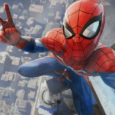If all of the waxing poetic about the game wasn’t an indicator, I like it. Superficially, Divekick is a joke. Obviously. One of the characters is a doctor named Dr. Shoals who has rocket boots and its looking for a cure for a foot disease called Foot Dive. Of course it’s a joke.
As Divekick matured, its roster grew, and with more characters, things to distinguish between characters needed to be added. As a result the roster is significantly expanded, allowing players to choose a character to fit their playstyle. With that comes a certain degree of having to learn a character and I was initially scared that this would mean the end of what I enjoy most about Divekick—its transparency. But as I played, I found that these fears were unfounded as it’s as complex as it is understandable. The metagame of Divekick—trying to figure out when your opponent will attack, how high they’ll jump, etc…—is incredibly complex, but the controls and movesets are so limited, you’re always in control and your opponent’s moves are never an unknown.
 Put simply, that’s why Divekick is currently my favorite fighting game. There’s nothing mystifying about it. If you lose, it’s because the other person is either faster with their fingers than you, able to outsmart your moves, or lucky enough to land the first hit. And when you are defeated, you see exactly what happened and you can learn from it. Divekick is the first fighting game I’ve ever played in which I didn’t feel alienated when playing friends proficient in fighting games, and that’s intensely satisfying. Even playing pros online, I could win a few matches because I happened to position myself in such a way that they were caught off guard.
Put simply, that’s why Divekick is currently my favorite fighting game. There’s nothing mystifying about it. If you lose, it’s because the other person is either faster with their fingers than you, able to outsmart your moves, or lucky enough to land the first hit. And when you are defeated, you see exactly what happened and you can learn from it. Divekick is the first fighting game I’ve ever played in which I didn’t feel alienated when playing friends proficient in fighting games, and that’s intensely satisfying. Even playing pros online, I could win a few matches because I happened to position myself in such a way that they were caught off guard.The game features single player mode, which has exactly as much story as you’d expect—somewhere between five and six panels of moving comics plus three dialogue banter sessions. Of course there’s a local versus mode, even on the Vita, but there’s also an online portion which boasts the best netcode of any fighter out there. To be fair though, I’ve had more than one match with a little lag, and one in which the loading screen came up for a few seconds before the battle resumed.
The art style is hand drawn and can be a little amateurish at times, but it all fits with the themes of the game. The music is unobtrusive and the backgrounds aren’t distracting, lending to the idea that in Divekick, combat is king. Just like in most fighters, you can complete story mode in about half an hour per character if you’re bad. Matches are completed in anywhere between 15 seconds and the absolute maximum of 3 minutes, meaning it’s as quick as it is intense.
Verdict: Come on, have I not gushed enough? Divekick is hands down the most simple, elegant, fair, and accessible fighter I’ve ever played. To fighting game terri-bads like myself, it’s perfect since the investment to get proficient is so low. And to fighter pros, it’s also perfect since the movesets are so simple, you’re forced to be creative and quick thinking to pull off a victory against a seasoned pro. Or lucky. That’ll work too.
Just go buy it, come on man.
As a side note, Iron Galaxy was kind enough to give me a review code for the game the day before its release on a far too late request from me. Even though he wasn’t in the office, the CEO himself handled my request quickly and got me the code very quickly, so thanks so much to Dave Lang. Also for the record, I bought the game on Steam just so I could support them with my dollars. You should too!
Indie titles have been gaining tons of traction lately. With titles like Minecraft and Bastion showing AAA companies and gamers that you don’t need a staff of hundreds to create high quality products, more people have been willing to give good ole indies a try. And that’s how I stumbled upon Guacamelee. I needed something to play on a plane ride and after downloading Final Fantasy VI for the fifth time, I decided I wanted a change. I’d heard the name before, but only knew it was an indie title having something to do with luchadors. On a $15 whim, I downloaded it and played it on my Vita. Is it as entertaining as the title suggests, or would I wish I had just said nah-chos?
Guacamelee stars Juan Aguacate, an agave farmer with a magic luchador mask on a mission to save his childhood friend and possible love interest, who also happens to be El Presidente’s daughter, from the evil undead skeleton Calaca. The story not only features Mexican folklore, but embraces is wholly and gives its own take. From the land of the dead to the building architecture and casual Spanish, this game really takes on the culture of Mexico and makes it accessible by having fun with it.
This game not only pulls from Mexican folklore, but from internet and video game culture for its jokes. With luchador posters featuring the likenesses of Bane and Batman to Super Meat Boy and Mega Man, and even Grumpy CAt, this game has so many in-jokes, you’re always looking for more. In fact, the primary way you get new moves is by destroying Choozo statues. If you’re a fan of the Metroid series, you’ll spot the similarities immediately. The most impressive thing about these references is that none of them feel gimmicky or out of place. In the same way that Guacamelee takes on Mexican culture by integrating it into the game, so too is the culture cultivated by the gaming community.
The gameplay is excellent. It’s basically a platforming puzzle-ish game with bosses. Think Metroid, but with melee only weapons. Well-balanced enemies along with a snappy and intuitive combat system make fights challenging, but never overly frustrating. After pummeling an enemy enough, you can pick them up to throw them at others, adding another dynamic to play in that you may want to focus on a group of enemies quickly just to pick up one and throw him at the rest, leading you into a tossing parade of baddie carcasses across the screen.
It’s great.
Another interesting aspect about the combat is that your special moves are not only utilized in fights, but also just to navigate. The first move you get is a punch that sends you skyward and it acts as a sort of second jump when you need just a little extra height. In the same way bombs in Metroid can let you ball-hop, the versatility of moves in Guacamelee aren’t just limited to combat, a design choice I quite enjoy.
The art style, as you can tell by the images above, is relatively simplistic. It looks almost hand-drawn, like Samurai Jack. The simple art style means that variations in color mean much more. For example, when the hyper-colorful splash screen that means you got a power-up appears, it feels really visually satisfying. The less intense graphics also mean that the frame-rate is buttery smooth all the time.
The game also features co-op, letting one other friend join in on the baddy smashing action. Though you do have to be connected to the same system, meaning no luck for Vita-only owners, you can connect the Vita to a PS3 to jump in.
Another quick point to note is that the power-up controls felt sloppy on the PS3. I had no problems selecting what move to use on my foes on Vita, but when I switched to my old Sixaxis, I had to be more precise with my motions.
Verdict: Overall, Guacamelee is a fantastic game, especially for the price. It’s funny without being annoying, the combat is fluid and dynamic, and it has enough replay value to warrant playing a few times. If you like games like Metroid or the enemy-juggling of Devil May Cry, Guacamelee is the next indie title you’ll fall for.
 OK. Sometimes when a company tries to do a big reveal, they go one of a couple different directions. First is the Apple route – blacking out room windows in R&D, attaching test devices to desks at Apple HQ, and even masking field testing units with external casing to make sure no one knows what’s up. Sure it may not seem like that’s how they roll now, but that’s how they do things. Get their audience so amped that whatever they introduce is an instant hit they’ve all been waiting for.
OK. Sometimes when a company tries to do a big reveal, they go one of a couple different directions. First is the Apple route – blacking out room windows in R&D, attaching test devices to desks at Apple HQ, and even masking field testing units with external casing to make sure no one knows what’s up. Sure it may not seem like that’s how they roll now, but that’s how they do things. Get their audience so amped that whatever they introduce is an instant hit they’ve all been waiting for.
The second is the straightforward method. That’s more or less saying “hey kids, product X is going to e out on the 37th of Zuhtember (naturally “X’ and “Zuhtember” being code for a number and who gives a damn). But in this case potential customers know exactly what’s coming and what’s going to be involved. I guess the cleanest example here after the Apple thing would be Samsung and their Galaxy phones if you want an example.
 So both of those methods make sense, and we’ve seen both dozens of times before. What confuses me sometimes is when some companies try to blend the two of these in some sort of “openly secretive” teaser thrown out onto the interwebs. Which is the route that Sony took today with their latest teaser on their official US website. Go ahead, watch it. It has all the elements of a big reveal – flashy effects, zoomed shots of different aspects of what gets collected for a final image, and of course mystic and cryptic heavy beats in the background to add an ambiance of mystery and allure. Sweet. Even a date and a time for a very special event so fans have something to look forward to. So what could it possible be? My interest is now piqued beyond recognition – WHAT COULD IT BE? Four very familiar shapes – a triangle, a circle, an X, and is that… is that a square?
So both of those methods make sense, and we’ve seen both dozens of times before. What confuses me sometimes is when some companies try to blend the two of these in some sort of “openly secretive” teaser thrown out onto the interwebs. Which is the route that Sony took today with their latest teaser on their official US website. Go ahead, watch it. It has all the elements of a big reveal – flashy effects, zoomed shots of different aspects of what gets collected for a final image, and of course mystic and cryptic heavy beats in the background to add an ambiance of mystery and allure. Sweet. Even a date and a time for a very special event so fans have something to look forward to. So what could it possible be? My interest is now piqued beyond recognition – WHAT COULD IT BE? Four very familiar shapes – a triangle, a circle, an X, and is that… is that a square?
Look at the video kids. It’s gonna be the PlayStation 4. I mean I can’t for sure say it, but watch it again. Search your feelings. I don’t think you really need the force with you to sense this one.
The date? February 20th, at 6:00pm. The teaser is an ad for the Playstation Meeting, which is a venue where Sony’s unveiled consoles and hardware before (that’s where they unveiled the Vita before), so the PS4’s a feasible prediction. And Sony wanting to beat Microsoft to the punch on consoles does make sense too. There’s also a chance that maybe they could be releasing the fruits of their venture with Gaikai, but MY PEOPLES – I’m still calling PS4.
Tushar Nene
Staff Writer
@tusharnene





























